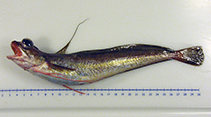Add your observation in Fish Watcher
| Native range | All suitable habitat | Point map | Year 2050 |

|
| This map was computer-generated and has not yet been reviewed. |
| Urophycis chuss AquaMaps Data sources: GBIF OBIS |
Upload your photos and videos
Pictures | Sounds | Google imageUrophycis chuss
Picture by Mac Eachern, W.J.
Pictures | Sounds | Google imageUrophycis chuss
Picture by Mac Eachern, W.J.
Common names from other countries
Classification / Names ຊື່ສາມັນ | ຄຳສັບຄ້າຍຄືກັນ | Catalog of Fishes(ຕະກຸນ, ຊະນິດ) | ITIS | CoL | WoRMS | Cloffa
> Gadiformes (Cods) > Phycidae (Phycid hakes)
Etymology: Urophycis: Greek, oura = tail + Greek, phyke, pykis, -idos = the female of a fish that lives among algae (Greek = phykon), related with the gudgeon (Ref. 45335).
More on author: Walbaum.
Etymology: Urophycis: Greek, oura = tail + Greek, phyke, pykis, -idos = the female of a fish that lives among algae (Greek = phykon), related with the gudgeon (Ref. 45335).
More on author: Walbaum.
Environment: milieu / climate zone / depth range / distribution range ນິເວດວິທະຍາ
ສັດທະເລ ອາໄສຢູ່ໃກ້ໜ້າດິນໃຕ້ພື້ນທ້ອງນ້ຳ; ປາທີ່ມີການເຄື່ອນຍ້າຍໃນສະເພາະມາະຫາສະມຸດ (Ref. 51243); ລະດັບຄວາມເລິກ 35 - 1152 m (Ref. 57178), usually 110 - 130 m. Temperate; 51°N - 33°N, 79°W - 58°W
ການແຜ່ກະຈາຍ ປະເທດ | ເຂດ FAO | ລະບົບນິເວດ | ການປະກົດຕົວ | Point map | ການແນະນຳ | Faunafri
Northwest Atlantic: North Carolina to southern Nova Scotia, straying to the Gulf of St. Lawrence. Rare European records are probably misidentifications of Urophycis tenuis.
Length at first maturity / ຂະໜາດ / ນ້ຳໜັກ / Age
Maturity: Lm 26.0 range ? - ? cm
Max length : 66.0 cm TL ຕົວຜູ້/ບໍ່ມີເພດ; (Ref. 40637); ນ້ຳໜັກສູງສຸດທີ່ເຄຍຈັດພີມມາ: 3.6 kg (Ref. 40637)
Max length : 66.0 cm TL ຕົວຜູ້/ບໍ່ມີເພດ; (Ref. 40637); ນ້ຳໜັກສູງສຸດທີ່ເຄຍຈັດພີມມາ: 3.6 kg (Ref. 40637)
Short description ຕົວທີ່ໃຊ້ໃນການຈຳແນກຊະນິດ | ສະລີລະວິທະຍາ | ການວັດແທກຮູບຮ່າງລັກສະນະພາຍນອກຂອງດິນ,ສັດ,ປາ…
ຄີ (ໜາມ)ແຂງຢູ່ຫຼັງປາ (ທັງໝົດ) : 0; ຄີ(ໜາມ) ແຂງຢູ່ຄີກົ້ນປາ
ກຸ່ມປາກະດູກແຂງ
ຄວາມຖີ່ຂອງກຸ່ມຖ່າຍທອດພັນ
ປາທີ່ມີການເຄື່ອນຍ້າຍຈາກທະເລໄປຫານ້ຳຈືດ ແລະນ້ຳຈືດຫາທະເລ
ປາທີ່ມີການເຄື່ອນຍ້າຍຈາກທະເລແລະໄປໄຂ່ຢູ່ນ້ຳຈືດ
ຄີກົ້ນຂອງປາ
ສັດທີ່ມີກະດູກສັນຫັຼງ
ການຖ່າຍທອດທາງກຳມະພັນຈາກພໍ່ແມ່ຫາລູກ: 0. First dorsal fin ray elongated. Pelvic fins also reaching about the anal fin origin. Body color variable, reddish to olive brown dorsally, sometimes very dark or mottled; lower sides paler, sometimes with dusky dots; belly and underside of the head pale. A dusky blotch present on the opercle. The fins are generally dark, except for the pelvic fins, which are pale.
Found on soft muddy and sandy bottoms, but never on rocks, gravel or shells. Juveniles live along the coasts at shallow depths (4-6 m); adults migrate to deeper waters, generally to between 110 and 130 m, and in some instances, to over 550 m. Juveniles live in scallops (Placopecten magellanicus) and remain close to scallop beds until they mature (Ref. 9988). They prefer temperatures of 8-10°C (Ref. 5951). Feed on shrimps, amphipods and other crustaceans, also on squid and herring, flatfish, mackerel and others. Utilized fresh, dried or salted and frozen; also small fish are used for fishmeal ; eaten steamed, microwaved and baked (Ref. 9988). Maximum depth reported from Ref. 57178.
Life cycle and mating behavior ການຈະເລີນເຕັມໄວ | ການສືບພັນ | ການວາງໄຂ່ | ໄຂ່ | ຄວາມດົກຂອງໄຂ່ປາ | ຕົວອ່ອນ
Main reference
Upload your references | ເອກະສານອ້າງອີງ | ຜູ້ປະສານງານ | ຜູ້ຮ່ວມມື
Cohen, D.M., T. Inada, T. Iwamoto and N. Scialabba, 1990. FAO species catalogue. Vol. 10. Gadiform fishes of the world (Order Gadiformes). An annotated and illustrated catalogue of cods, hakes, grenadiers and other gadiform fishes known to date. FAO Fish. Synop. 125(10). Rome: FAO. 442 p. (Ref. 1371)
Threat to humans
Harmless
Human uses
ການປະມົງ: ເປັນສີນຄ້າ; ຊະນິດປາທີ່ຖືກນຳໃຊ້ເຂົ້າໃນການຫາເພື່ອເປັນເກມກິລາ: ແມ່ນ
FAO(ການປະມົງ: ຜົນຜະລິດ; publication : search) | FishSource | ທະເລອ້ອມຂ້າງພວກເຮົາ
ຂໍ້ມູນຕື່ມອີກ
Population dynamics
ຕົວວັດແທກການເຕີບໃຫຍ່
Max. ages / sizes
Length-weight rel.
Length-length rel.
Length-frequencies
Mass conversion
ການທົດແທນທີ່
ຄວາມອຸດົມສົມບູນ
ຕົວວັດແທກການເຕີບໃຫຍ່
Max. ages / sizes
Length-weight rel.
Length-length rel.
Length-frequencies
Mass conversion
ການທົດແທນທີ່
ຄວາມອຸດົມສົມບູນ
Life cycle
ການສືບພັນ
ການຈະເລີນເຕັມໄວ
ຄວາມດົກຂອງໄຂ່ປາ
ການວາງໄຂ່
Spawning aggregations
ໄຂ່
Egg development
ຕົວອ່ອນ
ການປ່ຽນແປງຂອງຕົວອ່ອນ
ການສືບພັນ
ການຈະເລີນເຕັມໄວ
ຄວາມດົກຂອງໄຂ່ປາ
ການວາງໄຂ່
Spawning aggregations
ໄຂ່
Egg development
ຕົວອ່ອນ
ການປ່ຽນແປງຂອງຕົວອ່ອນ
Anatomy
ເນື້ອທີ່ເຫືອກ
Brain
Otolith
ເນື້ອທີ່ເຫືອກ
Brain
Otolith
Physiology
Body composition
Nutrients
ການບໍລິໂພກອົກຊີເຈນ
ປະເພດການລອຍ
ຄວາມໄວໃນການລອຍ
Visual pigments
Fish sound
Diseases & Parasites
Toxicity (LC50s)
Body composition
Nutrients
ການບໍລິໂພກອົກຊີເຈນ
ປະເພດການລອຍ
ຄວາມໄວໃນການລອຍ
Visual pigments
Fish sound
Diseases & Parasites
Toxicity (LC50s)
Genetics
ກຳມະພັນ
Heterozygosity
ການຖ່າຍທອດທາງກຳມະພັນຈາກພໍ່ແມ່ຫາລູກ
ກຳມະພັນ
Heterozygosity
ການຖ່າຍທອດທາງກຳມະພັນຈາກພໍ່ແມ່ຫາລູກ
Human related
Aquaculture systems
ຂໍ້ມູນການລ້ຽງສັດນ້ຳ
ສາຍພັນ
Ciguatera cases
Stamps, coins, misc.
Aquaculture systems
ຂໍ້ມູນການລ້ຽງສັດນ້ຳ
ສາຍພັນ
Ciguatera cases
Stamps, coins, misc.
ເຄື່ອງມື
E-book | ຄູ່ມືພາກສະໜາມ | ຕົວທີ່ໃຊ້ໃນການຈຳແນກຊະນິດ | ຄວາມຖີ່ຂອງຄວາມຍາວປາ | ເຄື່ອງມືຂອງຊີວະປະຫວັດທາງດ້ານຊີວິດ | ຈຸດໃດໜຶ່ງທີ່ສະແດງອອກໃນແຜນທີ່ (ພ້ອມທັງສະແດງຂໍ້ມູນເພີ້ນເຕີມ) | Classification Tree
| Catch-MSY |
Special reports
Download XML
ແຫຼ່ງອີນເຕີເນັດ
Aquatic Commons | BHL | Cloffa | Websites from users | Check FishWatcher | CISTI | Catalog of Fishes(ຕະກຸນ, ຊະນິດ) | DiscoverLife | ECOTOX | Faunafri | Fishtrace | GenBank(genome, nucleotide) | GloBI | GOBASE | | Google Books | Google Scholar | Google | IGFA World Record | MitoFish | Otolith Atlas of Taiwan Fishes | ບ່ອນວາງສະແດງສັນນ້ຳຂອງລັດ | PubMed | Reef Life Survey | Scirus | SeaLifeBase | ແຜນທີ່ສະແດງກິ່ງງ່າຂອງເຊື້ອຕະກຸນປາ, ສັດ ຈາກບັນພະບູລຸດຈົນເຖິງຫລານ | Wikipedia(Go, ຊອກຫາ) | World Records Freshwater Fishing | ການບັນທຶກດ້ານສັດວິທະຍາ
Estimates based on models
Preferred temperature (Ref. 115969): 1.6 - 11.1, mean 5 (based on 23 cells).
Phylogenetic diversity index (Ref. 82804): PD50 = 0.5044 [Uniqueness, from 0.5 = low to 2.0 = high].
Bayesian length-weight: a=0.00407 (0.00319 - 0.00520), b=3.11 (3.04 - 3.18), in cm Total Length, based on LWR estimates for this species (Ref. 93245).
ຊັ້ນເຂດຮ້ອນ (Ref. 69278): 3.7 ±0.3 se; based on diet studies.
ຄວາມຢືດຢຸ່ນ (Ref. 120179): ຂະໜາດກາງ, ປະຊາກອນຕຳ່ສຸດທີ່ໃຊ້ເວລາສອງເທົ່າ 1.4 - 4.4 ປີ (K=0.19; tm=2-3).
Prior r = 0.20, 95% CL = 0.13 - 0.30, Based on 3 full stock assessments.
Fishing Vulnerability (Ref. 59153): Moderate to high vulnerability (51 of 100).
Climate Vulnerability (Ref. 125649): Moderate to high vulnerability (52 of 100).




